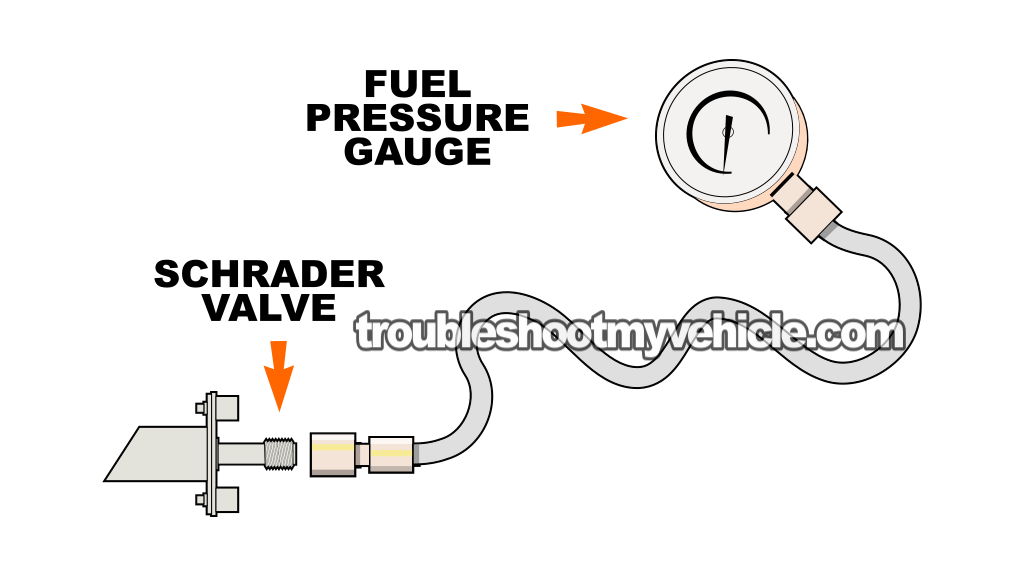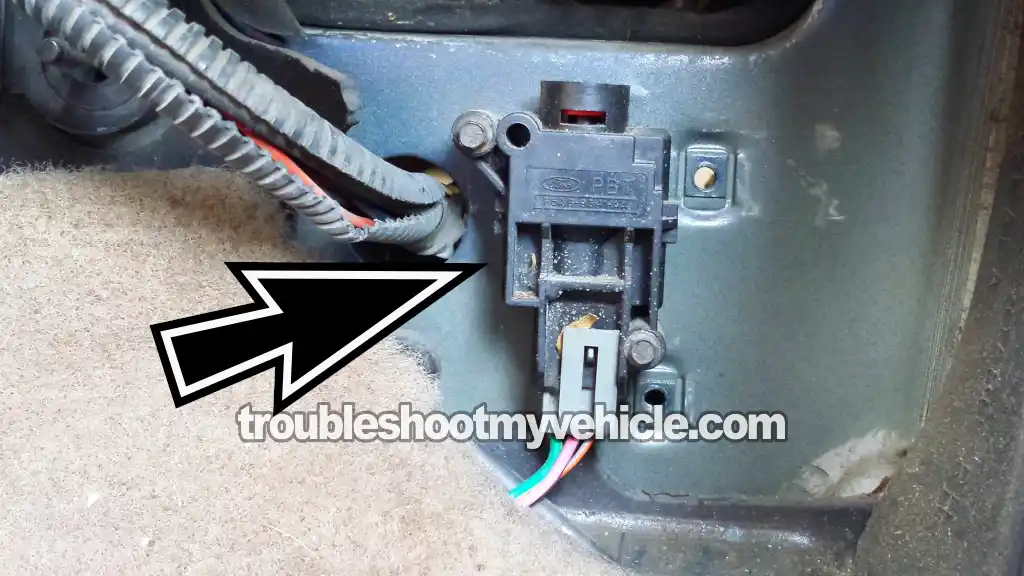
One of the easiest ways to figure out if your fuel pump is failing —or completely dead— is by connecting a fuel pressure gauge to the Schrader valve on the fuel injector rail of your 2001–2003 4.0L Ford Explorer (Mercury Mountaineer).
Ford made this simple by placing that valve in an accessible spot on the engine (right behind the ignition coil pack), so there's no need for special tools or complicated setups.
Whether your 4.0L Ford V6 engine won't start at all or just feels underpowered when driving, zero or low fuel pressure could be the root cause.
In this tutorial, I'll walk you through how to test the fuel pump's fuel pressure step-by-step —and explain exactly what your results mean. I'll also show you how to do a Starting Fluid test that doesn't require any tools, to help you confirm if the no-start is fuel-related.
Contents of this tutorial:
- How To Tell If Your Fuel Pump Is Going Bad (The Symptoms).
- Where To Buy A Fuel Pressure Gauge.
- TEST 1: Checking Fuel Pressure With A Gauge.
- TEST 2: Starting Fluid Test.
- Checking The Fuel Pump Inertia Switch.
- More Fuel Pump Troubleshooting Help.
- Where To Buy The Fuel Pump And Save.
- More 4.0L V6 Ford Explorer Tutorials.
IMPORTANT: Gasoline is extremely flammable! Take all necessary safety precautions, be alert, be careful. Starting fluid and gasoline can ignite very easily.
APPLIES TO: This tutorial applies to the following vehicles:
- 4.0L V6 Ford Explorer: 2001, 2002, 2003.
- 4.0L V6 Mercury Mountaineer: 2001, 2002, 2003.
MORE FUEL PUMP DIAGNOSTIC RESOURCES: You can find fuel pump circuit wiring diagrams, related fuel pump tests, and the inertia switch tests in this section:
How To Tell If Your Fuel Pump Is Going Bad (The Symptoms)
When a fuel pump starts to fail, it usually does so in one of two common ways:
- The pump gives out completely: The engine cranks but won't start because there's no fuel making it to the injectors.
- The pump hasn't died yet —but it's struggling: The engine runs, but poorly, since the pump is only delivering enough fuel to get it started, but not enough to keep it running smoothly, especially under load.
You might notice a few warning signs that your fuel pump is either on its last legs or already toast:
- Engine no-start condition: You turn the key, and the engine just cranks over and over without actually starting.
- Starts then stalls: It might catch and start up fine, but then die out a few seconds later —like it ran out of fuel.
- Stalls when accelerating: It idles okay, but the second you drop it in Drive and give it gas, it stumbles and shuts off.
- Weak acceleration or power loss: It feels sluggish, like the engine is starving for fuel —especially when trying to pick up speed or climb a hill.
- Popping sounds from under the hood: Backfires can happen if the air-fuel mixture goes too lean —often a clue the fuel pump isn't keeping up.
- Check engine light + lean codes: Trouble codes like P0171 or P0174 point to a lean condition, and a weak fuel pump is often one of the usual suspects.
That's why it's critical to verify fuel pressure with a fuel pressure gauge before replacing anything. If your fuel pressure is on point, but the engine still won't start, then the problem lies elsewhere — and that's exactly what this guide will help you track down:
And if you don't already have a gauge, don't worry —in the next section, I'll show you exactly where to pick one up for cheap...
Where To Buy A Fuel Pressure Gauge
I've used all kinds of fuel pressure gauges from different tool brands over the years, and the ones below are the ones I trust and recommend. These are solid picks for the DIYer —affordable, dependable, and they come with the right adapter to hook up to your Explorer's Schrader valve:
Disclosure: As an Amazon Associate, I earn from qualifying purchases. Buying through these links helps support this site at no extra cost to you. Thanks for your support —it really means a lot!
TEST 1: Checking Fuel Pressure With A Gauge

Like I mentioned earlier, testing the fuel pump with a gauge is one of the easiest and most reliable ways to know what's really going on with your Explorer or Mountaineer's fuel pump.
And the thing that makes it easy is that your 2001-2003 Ford 4.0L V6 comes with a test port (commonly known as the Schrader valve) right on the fuel injector rail that's on the passenger side of the engine (behind the ignition coil pack).
The test port is the same kind of valve used on a tire, and it's where the gauge hooks up.
If you don't have a gauge yet, you've got two options: head down to your local AutoZone or O'Reilly and borrow one (they'll just hold a small deposit), or pick one up for yourself —I've listed a few solid ones I trust here: Where To Buy A Fuel Pressure Gauge.
Next, let's look at the fuel pressure specs you'll need to compare your readings against:
NOTE: Before jumping into this test, make sure you've already checked the fuel pump inertia switch. If that switch is tripped, it cuts off power to the pump and mimics a dead fuel pump. You can find the exact steps here: Checking The Fuel Pump Inertia Switch.
WHERE TO FIND THE SCHRADER VALVE: On the 2001-2003 4.0L Explorer (Mountaineer), the Schrader valve is on the passenger side of the engine —mounted at the front of the fuel injector rail. You'll spot it behind the ignition coil pack.
Alright, let's walk through this fuel pressure test step by step:
- 1
Slide a shop towel under the Schrader valve. This is just in case a bit of fuel leaks out when you connect the adapter, the towel will catch it.
- 2
Thread the Ford Schrader valve adapter onto the valve. Make sure it's snug and tight to avoid any leaks.
- 3
Connect your fuel pressure gauge to the adapter. You're now ready to check pressure.
- 4
Have your helper turn the key ON, then OFF several times in quick succession —without cranking the engine.
Watch for leaks while the system pressurizes.
If everything stays dry, you're good to move on.
If fuel leaks out, stop and fix it before continuing.
Key On Engine Off (KOEO) Procedure: Engine doesn't start
- 5
Now have your helper crank the engine and then let go of the key while you keep an eye on the gauge.
NOTE: When your helper let's go of the key, it'll stay in the RUN position. If he switches the key all the way to the OFF position, he's not doing it right. - 6
The gauge will give you one of two results:
1.) It shows fuel pressure within the correct spec.
2.) It shows little or no pressure —which means there's a problem.
Key On Engine Off (KOEO) Procedure: Engine starts (but you need to see the KOEO fuel pressure)
- 5
Disconnect the ignition coil pack from its electrical connector. This will keep the engine from starting.
- 6
Now have your helper crank the engine and then let go of the key while you keep an eye on the gauge.
NOTE: When your helper let's go of the key, it'll stay in the RUN position. If he switches the key all the way to the OFF position, he's not doing it right. - 7
The gauge will give you one of two results:
1.) It shows fuel pressure within the correct spec.
2.) It shows little or no pressure —which means there's a problem.
Key On Running (KOER) Procedure: Engine starts and runs
- 5
Now have your helper crank the engine and then let go of the key while you keep an eye on the gauge.
- 6
The gauge will give you one of two results:
1.) It shows fuel pressure within the correct spec.
2.) It shows little or no pressure —which means there's a problem.
Now that you've run the test, let's break down what your results actually mean:
CASE 1: You got 0 PSI on the gauge. That tells you there's no fuel reaching the injectors —and that's why the engine won't start.
But before calling the fuel pump dead, I always double-check two things:
- First, make sure that the inertia switch hasn't tripped and cut power to the pump. You can follow this guide: Checking The Fuel Pump Inertia Switch.
- If the switch is OK, then I confirm that the fuel pump is getting power while cranking the engine. That rules out the relay and fuse. This guide will help you with this easy test:
To check for power at the pump, grab a multimeter and set it to Volts DC. Back-probe the wire that feeds power to the pump. While your helper cranks the engine, watch the meter —you should see 12 Volts. If voltage is there but pressure is still at zero, there's no doubt: the fuel pump is shot and needs to be replaced.
CASE 2: The gauge shows correct fuel pressure. That's great news —your fuel pump is doing its job.
If your engine still isn't starting, something else is causing the problem. The pump's off the hook. For more help pinpointing the cause, check out this guide:
TEST 2: Starting Fluid Test

The starting fluid test isn't the most precise way to troubleshoot fuel delivery issues that cause a no-start —but it's quick, simple, and surprisingly effective when used as part of a methodical engine no-start diagnostic strategy.
I've used this test countless times to point me in the right direction when dealing with a no-start. Just keep one thing in mind: before running it, make sure all six cylinders are getting spark —without spark, this test won't tell you anything useful.
NOTE: If you haven't already checked the fuel pump inertia switch, do that first. If it's tripped, the fuel pump won't run at all. For full details, go here: Checking The Fuel Pump Inertia Switch.
Alright, let's get to it:
- 1
Disconnect the intake duct from the throttle body. You don't need to take it off completely —just pull it back far enough to spray fluid in and reconnect it later.
- 2
Manually open the throttle plate and spray a good shot of starting fluid into the intake.
- 3
Reconnect the intake duct back onto the throttle body right away. Don't worry about tightening the clamp.
IMPORTANT: Always reconnect the duct before cranking the engine. It's a critical safety step in case you get a backfire through the intake. - 4
Have your helper crank the engine.
- 5
You'll get one of two outcomes:
1.) The engine starts briefly —then dies out after a few seconds.
2.) The engine just cranks and never catches.
Let's break down what your results tell you:
CASE 1: The engine fired up briefly, then shut off. This points to a lack of fuel being the reason it won't start —which usually means the fuel pump isn't doing its job.
Even though this result confirms that the engine no-start is due to a fuel delivery problem, if I were in your shoes, I would still confirm actual fuel pressure with a gauge: TEST 1: Checking Fuel Pressure With A Gauge.
CASE 2: The engine didn't start at all —not even for a second. That usually means fuel isn't your issue. Something else is keeping the engine from firing up.
Still, because the starting fluid test isn't always conclusive, I recommend checking the fuel pressure with a gauge. It's the most accurate way to know for sure: TEST 1: Checking Fuel Pressure With A Gauge.
Checking The Fuel Pump Inertia Switch

Your 2001-2003 4.0L V6 Ford Explorer or Mercury Mountaineer is equipped with a fuel pump inertia switch —a simple safety device designed to shut off the fuel pump in the event of a hard impact.
If this switch gets triggered, it cuts power to the fuel pump. So even though the engine may crank just fine, it won't start —because no fuel is reaching the injectors.
Now, this switch is supposed to activate only during serious accidents —but in the real world, I've seen it trip from things like hitting a deep pothole or the curb while parking. It happens more often than you'd think.
That's why it's always important to check the inertia switch first before spending time testing the fuel pump.
In 2001-2003 Explorer and Mountaineer covered in this guide, you'll find the inertia switch behind the passenger side kick panel, down below the dash on the right-hand side —just under the glove box area.
To reset it, all you have to do is press the large red button on top of the switch until it bottoms out. If the switch has been tripped, you'll feel and hear a distinct click when it resets.
Once you've reset it, try starting the engine again. If it fires up —problem solved. Now, the fuel pump inertia switch can be tested. If you need to, here's the tutorial:
- Fuel Pump Inertia Switch Tests (1991-2010 4.0L V6 Ford Explorer, Aerostar, And Mercury Mountaineer).
More Fuel Pump Troubleshooting Help
FUEL PUMP PRESSURE TESTS:
- How To Test The Fuel Pump (1993-2000 4.0L V6 Ford Explorer, Aerostar, And Mercury Mountaineer).
- How To Test The Fuel Pump (2004-2010 4.0L V6 Ford Explorer And Mercury Mountaineer).
FUEL PUMP INERTIA SWITCH TESTS:
- Fuel Pump Inertia Switch Tests (1991-2010 4.0L V6 Ford Explorer, Aerostar, And Mercury Mountaineer).
- Power To Fuel Pump Check (1991-2010 4.0L V6 Ford Explorer, Aerostar, And Mercury Mountaineer).
ENGINE NO-START DIAGNOSTICS:
FUEL PUMP CIRCUIT DIAGRAMS:
- Fuel Pump Circuit Wiring Diagram (1998-2001 4.0L Ford Explorer).
- Fuel Pump Circuit Wiring Diagram (2002 4.0L V6 Ford Explorer And Mercury Mountaineer).
- Fuel Pump Circuit Wiring Diagram (2003 4.0L V6 Ford Explorer And Mercury Mountaineer).
Where To Buy The Fuel Pump And Save
The following links will help you comparison shop for the fuel pump:
Disclosure: As an Amazon Associate, I earn from qualifying purchases. If my tutorials help you, using these links is an easy way to support the site at no extra cost to you. Thank you!
Not sure if the above fuel pumps fit your particular 4.0L Ford? Don't worry, once you get to the web-site they'll make sure it fits (by asking you for the specifics of your vehicle). If it doesn't fit, they'll find you the right one.
More 4.0L V6 Ford Explorer Tutorials
If you enjoyed and/or found this 'how to' tutorial helpful, I have written several more 4.0L V6 Ford Explorer (Mercury Mountaineer) specific test tutorials. You can find here:
The following tutorials are a sample of the articles you'll find in the index:
- How To Test Engine Compression (1991-2010 4.0L V6 Ford Explorer, Aerostar, And Mercury Mountaineer).
- How To Test The Fuel Injectors (1991-1996 4.0L Ford Explorer And Aerostar).
- How To Test The Coil Pack (Ford 3.0L, 3.8L, 4.0L, 4.2L) (at: easyautodiagnostics.com).
- How To Test The Ford Mass Air Flow (MAF) Sensor (at: easyautodiagnostics.com).
- How To Troubleshoot A No-Start Problem (1991-2010 4.0L V6 Ford Explorer, Aerostar, And Mercury Mountaineer).

If this info saved the day, buy me a beer!






